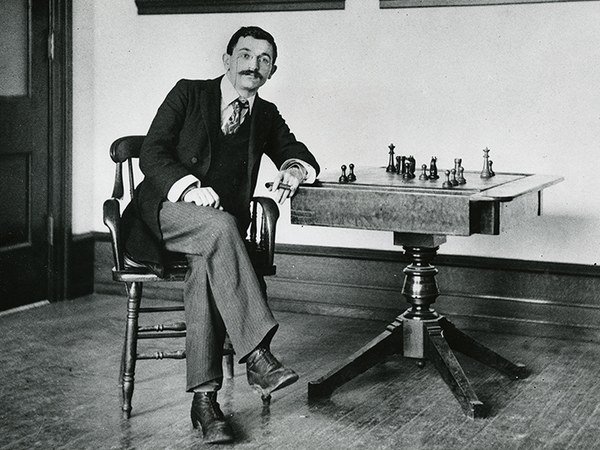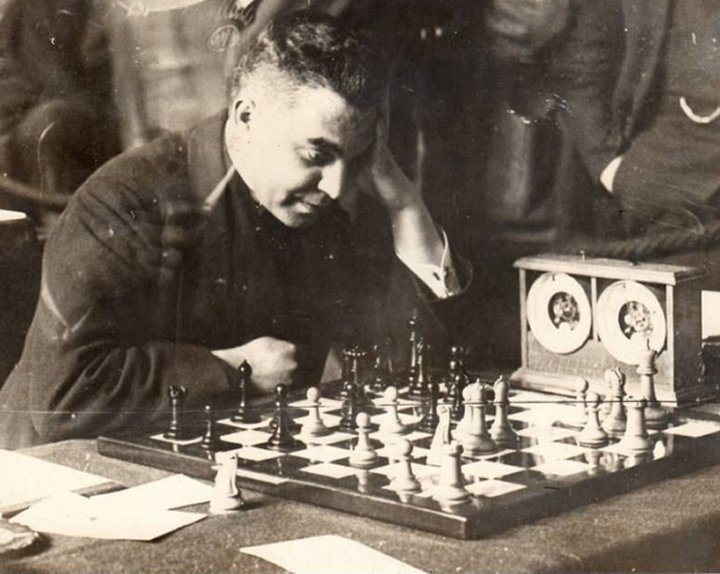New York 1924: Emanuel Lasker – psychology or strong moves?
In 1894 Emanuel Lasker became World Champion. At that time he had won a number of matches against strong players but not a single big international tournament. He took the direct route to the World Championship: he challenged the reigning World Champion Wilhelm Steinitz to a duel, defeated him and then was World Champion for the next 27 years until he lost his title to Capablanca in 1921.

A young Emanuel Lasker | Photo: Cleveland Public Library
But ever since Lasker became World Champion, colleagues, rivals, fans and critics have been wondering about the secret of Lasker's ongoing success. After all, his play in the opening is often careless and he does not seem to bother with deep theoretical studies. He is not a brilliant attacker like Alekhine, he lacks the brilliant simplicity Capablanca nor does he have the positional clarity of Rubinstein. However, he is a fantastic defender and there are an astonishing number of games in which he was clearly worse or even lost, but which he still won in the end.
Richard Reti has also noticed this phenomenon and it led him to make a bold statement in New York when characterizing the "Masters of Chess":
When I studied Lasker's games, I realized that he has a constant, at first sight incomprehensible luck. There are tournaments in which he took first and won almost every game though he was lost in about every second of them. It is an undeniable fact: Lasker again and again begins games badly, has hundreds of lost positions but still wins. The hypothesis of permanent luck is too unlikely. Someone who constantly achieves such successes must have a surprising power. But why then does he so often wind up in bad or lost positions? There is only one answer that sounds paradoxical but only at a superficial glance: Lasker often plays intentionally bad.
He first of all seeks to fight the psyche of his opponent and he does not try to play the objectively best moves, but the ones that are most unpleasant for the respective opponent.

Richard Reti
That is a bold claim that will certainly find its followers but it leaves the simple question unanswered how one can have lasting success in chess if one plays "intentionally bad". In fact, games such as those against Geza Maroczy in round seven of the New York tournament or Lasker's victory over Alekhine in round three of the New York tournament (and countless other games by Lasker) speak a completely different language. They show how strongly Lasker plays and why he was World Champion for 27 years and at the age of 55 is still one of the best players of the world.
Lasker had Black against Maroczy and after 1.e4 he followed Aljechin's example with 1...Nf6!?, which shows how quickly Lasker takes up current ideas and uses them to his advantage.
However, the game quickly transposed into a French Defence which Lasker treated originally and strongly. As if by magic all his pieces stood on the "right" squares after the opening and quickly came to life when Maroczy, who desparately tried to attack, weakened his position too much.
Lasker parried the white attack easily and then brought the game to a swift and tactically accurate conclusion.
Lasker's style may not be easy to define but against Maroczy he certainly didn't play "intentionally bad". Against Maroczy, Lasker definitely won with strong moves and not with psychology and it seems as if Reti underestimates the strength of the many unusual and new concepts in Lasker's games – such as attacking White's pawn chain with ...f6 in the French.
With this win Lasker took the sole lead in the tournament and with 4½ points from six games he is now half a point ahead of Capablanca, Alekhine and Reti.
Capablanca started the tournament in New York with four draws and a loss but then recovered with a brilliant rook ending against Tartakower in round six. In round seven, the World Champion continued to win and defeated Yates with a virtuoso performance of his knights.
Dawid Janowsky was probably not too impressed by these knight manoeuvres from Capablanca. After all, Janowsky is an ardent believer in the virtues of the bishops. Which he once again demonstrated in his fine win against Efim Bogoljubow.
Richard Reti played with White against Edward Lasker and he again opened with 1.Nf3 to test his hypermodern ideas. But he then treated the middlegame in a more classic way and showed why a knight on the rim is often dim.
Alexander Alekhine and Frank Marshall both enjoy the reputation of being excellent attacking players with a feeling for the dynamic of a position. And their game indeed quickly developed into a fascinating tactical exchange of blows, in which Marshall missed a few good chances in the end.
Results of round 7
G. Maroczy 0-1 Em. Lasker
J.R. Capablanca 1-0 F. Yates
E. Bogoljubow 0-1 D. Janowsky
R. Reti 1-0 Ed. Lasker
A. Alekhine ½-½ F. Marshall
Bye: Savielly Tartakower
Standings after seven rounds
Games
Links

























